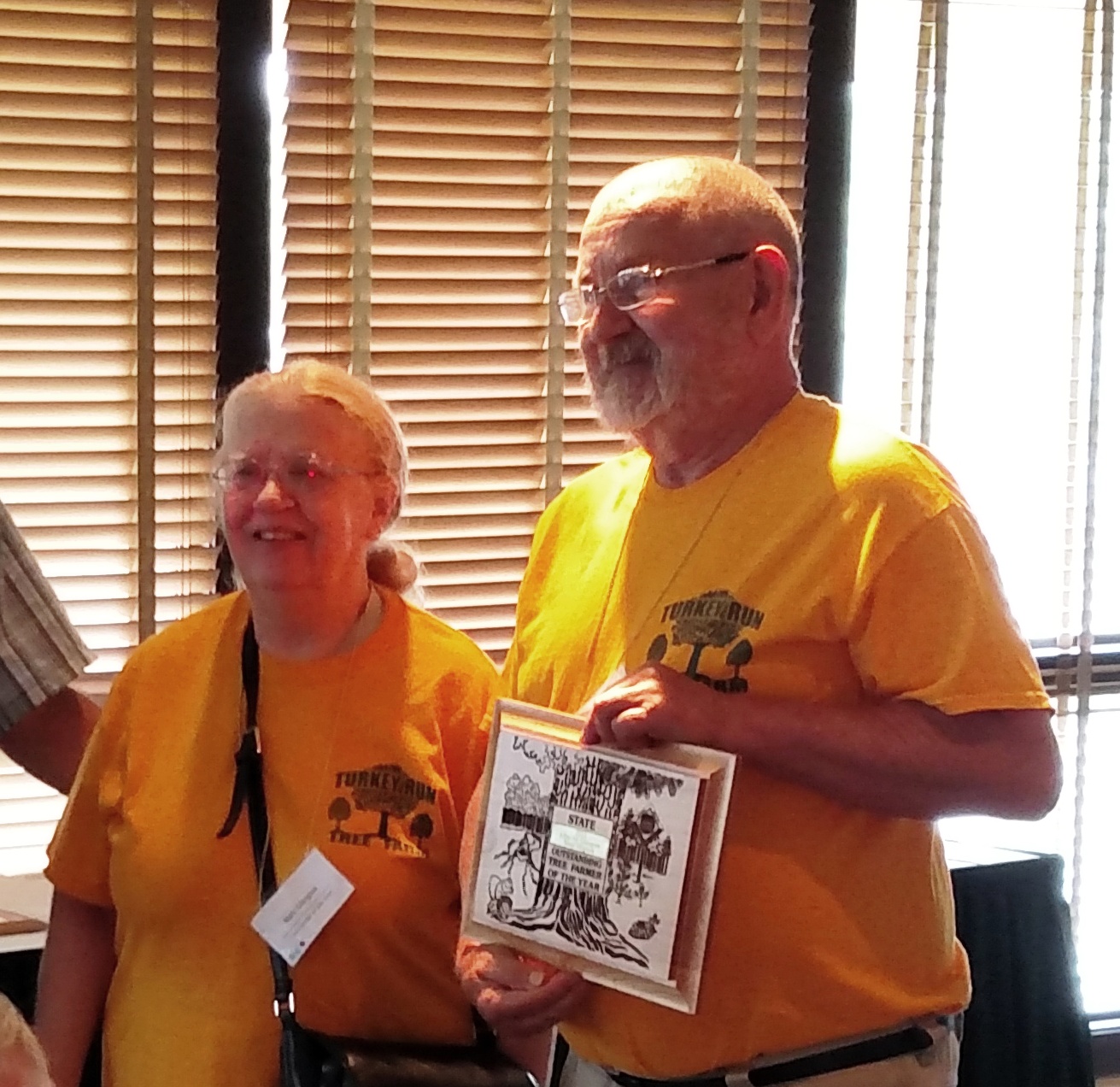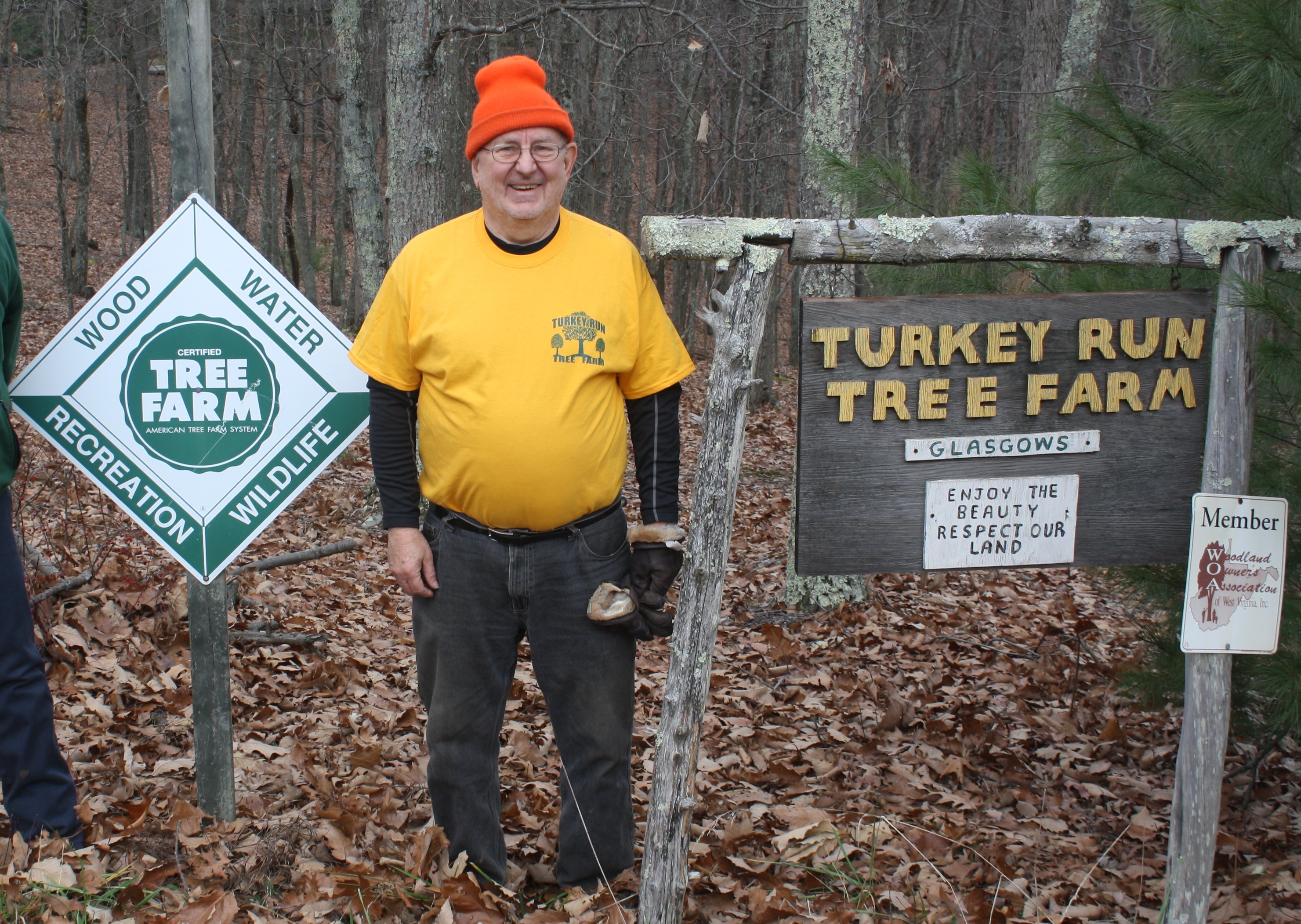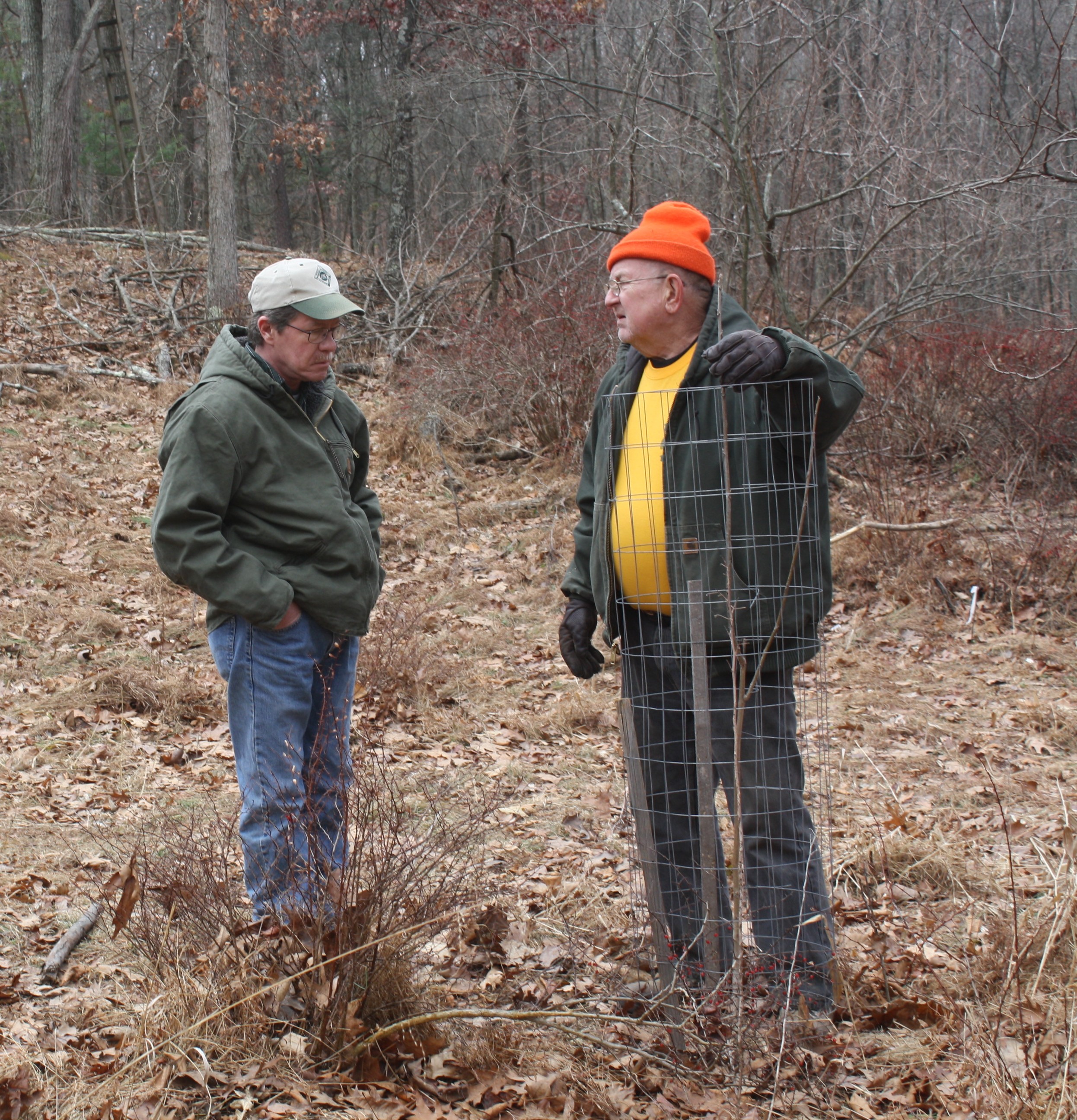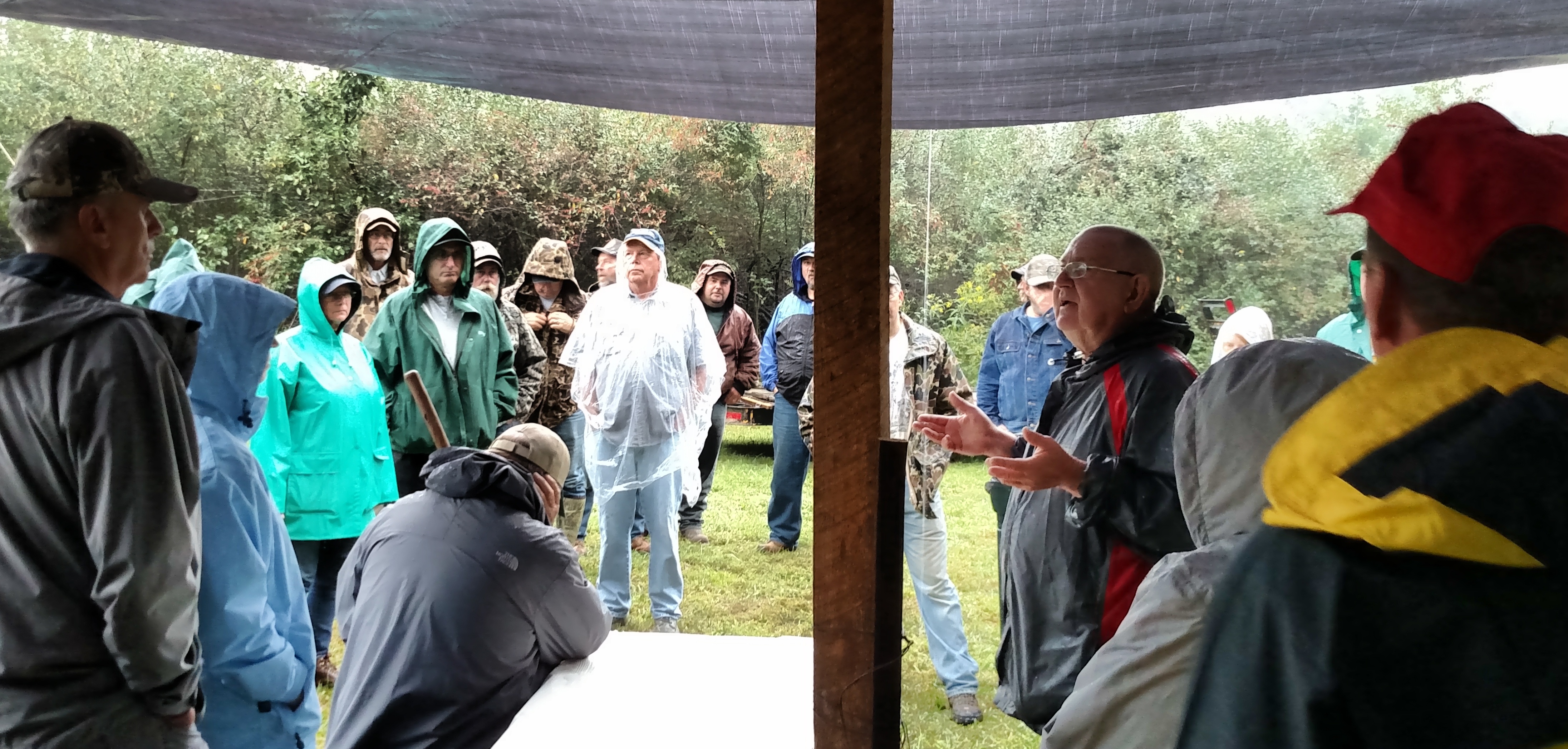Allen M. and Mary G. Glasgow from West Virginia

What makes them outstanding?
Dr. and Mrs. Glasgow take a proactive approach in the management of their forestland. They don't wait for something to happen and then react. They think ahead and put practices in motion to influence the future. For example they were one of the first landowners in the early 1990's to plant loblolly pine in their part of Hampshire County, West Virginia following a VA Pine clearcut. They were also two years ahead of the severe outbreak of Emerald Ash Borer and were able to salvage much of their ash sawtimber before it died. Dr. Glasgow has also been proactive and inventive in creating ways to protect newly planted hardwood trees from damage by deer. The forester doesn't have to call the Glasgow's to remind them of things to do; they are the one's who contact the forester to keep their forest management plan moving forward.It's also interesting to note the Dr. Glasgow's passion and interest is being passed on to the next generations. Mary and Allen's son has a home on the property and William has been assisting and learning from his father more many years. Even Williams’children are paying attention to what Grandpa is doing and they love coming to the Tree Farm for family fun and recreation.
Tree Farmer Story
 Allen M. Glasgow is a Tree Farmer who takes a passionate and pro-active approach in caring for his forestland. Through many years of failures and successes he has learned a few things on how to grow hardwood trees. Allen is so knowledgeable, and willing to share his experiences, that a friend of mine described him as guru in planting and growing hardwood seedlings. That description is very accurate, since one definition of a guru is “a trusted counselor and adviser, a mentor.” If a landowner wants to be counseled, advised or mentored on how to plant and grow hardwood trees then Allen M. Glasgow is the person to listen to.Dr. Glasgow began his Tree Farming experience in 1983 when he and his wife Mary purchased their first piece of land in Hampshire County, West Virginia. As a retired physician Allen wanted a property that he and his family could go to for fun and recreation. Over the years they purchased more adjoining parcels to create Turkey Run Tree Farm, a 241 acre property on the Cacapon River in the northeastern corner of Hampshire County. It didn’t take long for Allen to begin planting trees to benefit the wildlife and to create future crop trees.Allen and Mary Glasgow’s first forest management plan was prepared by David Sirna in 1989 who helped guide the Glasgow’s through their first timber sales during the late 1980s and early 1990s. Areas were selectively harvested to remove mature hardwood sawtimber and unacceptable pole trees. Other areas of poor quality hardwood were clearcut and converted to loblolly pine. Now these twenty two year old plantations are close to being ready for a harvest cut.From the very beginning Allen’s passion was to plant trees that would benefit the wildlife and produce sources of income in the future. He started planting paulownia, chestnuts, crabapples, pears, ash, yellow poplars, and other species at the rate of about 300 trees per year.
Allen M. Glasgow is a Tree Farmer who takes a passionate and pro-active approach in caring for his forestland. Through many years of failures and successes he has learned a few things on how to grow hardwood trees. Allen is so knowledgeable, and willing to share his experiences, that a friend of mine described him as guru in planting and growing hardwood seedlings. That description is very accurate, since one definition of a guru is “a trusted counselor and adviser, a mentor.” If a landowner wants to be counseled, advised or mentored on how to plant and grow hardwood trees then Allen M. Glasgow is the person to listen to.Dr. Glasgow began his Tree Farming experience in 1983 when he and his wife Mary purchased their first piece of land in Hampshire County, West Virginia. As a retired physician Allen wanted a property that he and his family could go to for fun and recreation. Over the years they purchased more adjoining parcels to create Turkey Run Tree Farm, a 241 acre property on the Cacapon River in the northeastern corner of Hampshire County. It didn’t take long for Allen to begin planting trees to benefit the wildlife and to create future crop trees.Allen and Mary Glasgow’s first forest management plan was prepared by David Sirna in 1989 who helped guide the Glasgow’s through their first timber sales during the late 1980s and early 1990s. Areas were selectively harvested to remove mature hardwood sawtimber and unacceptable pole trees. Other areas of poor quality hardwood were clearcut and converted to loblolly pine. Now these twenty two year old plantations are close to being ready for a harvest cut.From the very beginning Allen’s passion was to plant trees that would benefit the wildlife and produce sources of income in the future. He started planting paulownia, chestnuts, crabapples, pears, ash, yellow poplars, and other species at the rate of about 300 trees per year.
It didn’t take long to discover the many hazards in planting trees such as: competition from grasses and weeds, deer browsing, poor survival and growth due to poor root development, and bucks rubbing and scarring the trees. With each setback Allen was pro-active and inventive in finding ways to solve each problems. He purchased his planting stock from numerous sources but soon discovered the best source was from the West Virginia State Nursery. He experimented with gathering native nuts to grow seedlings. His whole approach was to think through the problems and find long term solutions.For example, in order to protect his trees he first used round plastic tubes with stakes. He discovered these were not strong enough. One other solution was to use plastic liter soda bottles, with the two ends cut out, and attaching them around the tree. This provided some relief from the deer, but was not always 100% protection. After several other attempts and inventive ideas, Allen discovered the best protection was from a wire cage. The wire cage encircled the entire tree from top to bottom and kept the deer away. However, wire was expensive to purchase so Allen became a “wire picker”.Everywhere he went he kept a watch for used wire. He would gather wire from any source, take it to the Tree Farm, and use it for his wire cages. He also would stock pile discarded outdoor decking for the wooden stakes. Once the decking was ripped to the correct width and cut to length it would support the cages. His storage shed next to the farm house has a good supply of wire and wooden stakes for future plantings.One of Allen’s most important seedling survival discoveries was to plant a seedling with the biggest and strongest root system.
from the deer, but was not always 100% protection. After several other attempts and inventive ideas, Allen discovered the best protection was from a wire cage. The wire cage encircled the entire tree from top to bottom and kept the deer away. However, wire was expensive to purchase so Allen became a “wire picker”.Everywhere he went he kept a watch for used wire. He would gather wire from any source, take it to the Tree Farm, and use it for his wire cages. He also would stock pile discarded outdoor decking for the wooden stakes. Once the decking was ripped to the correct width and cut to length it would support the cages. His storage shed next to the farm house has a good supply of wire and wooden stakes for future plantings.One of Allen’s most important seedling survival discoveries was to plant a seedling with the biggest and strongest root system.
If the seedlings had an underdeveloped root system, they would soon die from the grass and weed competition. Allen solved that problem by constructing raised beds to hold seedlings for one year. If the seeding grew in the raised bed, it would develop a root system that would sustain it through the first year of planting. In addition to the raised beds, Allen started to pre-plant his seedlings in pots and then transplant them in the field. The pots provide enough space for new root development and they are easier to handle in the spring during planting time. All of this requires a lot of planning and effort that takes several years before any seedling gets into the ground. Allen has already planned out the location of each planting spot for next spring. The cages are in place and identified so all he needs to do is drill the planting hole with his tractor, plant the seedling, and replace the cage. He and his helper can get several hundred seedlings in the ground in just a few hours.But as every Tree Farmer knows, nothing is guaranteed to succeed and Tree Farming is very unpredictable. For example Allen’s early plantings for a timber crop were white ash trees. Over the last several years Hampshire County has been invaded by the Emerald Ash Borer (EAB). Allen and Mary’s Tree Farm was hit hard. The EAB had infested all his native ash trees plus the young ash that Allen had planted just a few years ago. So again Allen was pro-active during this set back. He contracted with local logger Mr. James Gloyd, to harvest his mature ash sawtimber and pulpwood before the Emerald Ash Borer completing wiped out every tree. Unfortunately the young ash were not large enough to salvage and they remain standing and infested with EAB. Allen plans to replace these dying ash with yellow poplar seedlings over the next several years. In addition, in places where the removal of the mature ash left an under stocked stand, Allen has been filling in the open spaces with new plantings. It’s hard to see at this time, but in a few years these open areas will be fully stocked with trees due to Allen’s pro-active planting program.

Wood
- From 1983 to the present: Hardwood tree planting of various species. Approx. 300/trees/year.
- 1990: A hardwood selection harvest on approx. 48 acres involving bottom land hardwood sawtimber and pulpwood.
- 1993-1995: Virginia pine removal on 39 acres (five parcels) followed with replanting of loblolly pine.
- 1995 selection harvest on 67 acres of dry upland hardwood stand for sawtimber and pulpwood.
- 2012 another hardwood selection harvest on 48 acres of bottom land hardwoods that was thinned in 1990.
- 2012 Salvage harvest to remove dead and dying ash in 3 parcels on property.
- 2013 a pine and hardwood clearcut followed with loblolly pine replanting on 4 acres.
Water
Turkey Run Tree Farm lays on both sides of the Cacapon River in Hampshire County, West Virginia. Numerous hollows and streams flow through the Tree Farm and all forest management activities are conducted in manners to protect the watersheds. A stable rock ford is used to cross over the Cacapon River to access two timber stands. This ford is only used during period of low water flow and Dr. Glasgow has used it numerous times to access timber sales in those two timber stands. One steep slope is left untouched for management activities due to the fragile and steep soils that rise above the Cacapon River.
Wildlife
This is Turkey Run Tree Farms major management objective. All of his management activities are aimed at improving wildlife habitat; browse, cover, food sources, nesting sites, etc. Following is Dr. Glasgow's comments on his numerous experiences with Game Plantings:
- Chinese Chestnut: Hard to grow. We have only had success in our side yard. Absolutely the best deer attractant in early October. You can’t keep them away.
- Chinquapin: We have only had modest success. Bears tear them up.
- Pears: All of our pears except two oriental pears were grown from seed. Some were budded from a tree with larger pears. Attacked by fire blight but we have lost few and they continue to be very productive. Pears are hard and do not fall until late November early December. We have found pears to be much better than apples.
- Autumn Olive and Barberries: We have many volunteers. Years ago we bought select autumn olives from a nursery which were much more productive than wild type. Great for turkeys and birds.
- Fields: We have planted clover, buckwheat, rye, rape, turnips, sorghum, etc. but not for last 4-5 years.
No threatened and endangered species have been located on the property. However, Dr. Glasgow is well aware of their existence and importance during forest management. WV maintains a map based database of known locations of threatened and endangered species and this map has been checked to verify no locations on the Glasgow Tree Farm.
Recreation
Recreation: This was the first objective for Turkey Run Tree Farm. Dr. and Mrs. Glasgow originally purchased the property in 1983 as a place to relax, enjoy the country, and have fun with their children. The family would hike, fish and float in the Cacapon River, hunt in the woodlands, and just enjoy the quiet time away from the city. Numerous trails are established throughout the woodlands for hiking and the river access provides great opportunities for fishing and boating (canoes or tubing). Dr. and Mrs. Glasgow, and their children and grandchildren, still come to the Tree Farm 40-50 times a year to enjoy these same things. And any visitor is welcomed to stay and enjoy them also. However, if you're coming in the spring tree planting time...you may be "volunteered" into helping with some tree planting projects.
Aesthetics: Turkey Run Tree Farm has a board spectrum of scenic beauty. From the flat bottom land along the Cacapon River where the tall yellow poplar grow, to the steep rocky cliff that rise up from the River, the thick dark pine stands that are growing on the dry ridge tops, to the short steep little hollows and ridges of oak and hickory. The Tree Farm tops out at 969' and descends to about 550' along the river bottom. This creates some impressive views and vistas that the Glasgow's are proud to share with visitors and friends. One small observation hut was built at the top of the steep cliff providing a spectacular view of the rest of the Tree Farm, the Cacapon River, and miles of neighboring mountains, farms, and forests.


